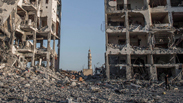
'Operation cannot be concluded without a real change in the balance of power in favor of Israel'
צילום: EPA
Reconstruction in return for demilitarization
Op-ed: Israel must make it clear that every truck of cement entering Gaza from the Israeli side will be followed by a truck of rockets exiting the Strip from the Egyptian side.
Even after the destruction of the Hamas tunnels, the main goal of Operation Protective Edge remains unchanged: A strategic change in Gaza.
While on the first week of fighting the IDF acted as if we were facing another violent round with the goal being to return home safely to the Pillar of Defense understandings, the following two weeks revealed that "yesterday's conception" was irrelevant for tomorrow.
The weakest military forces in the Middle East is still targeting Tel Aviv after 25 days of fighting, and it is hard to suppress the fact that the concluding image of the operation will be our updated business card in the neighborhood. Hezbollah, the Syrians, ISIS and the Iranians are this card's first circle of clients.
So the operation cannot be concluded without achieving a real change in the balance of power in favor of Israel, which will be based on effective demilitarization. A "strategic tie" in the enemy's eyes will be the future "mother of all wars." The flexibility area has shrunk. There is no longer a chance for yesterday's repeated rounds conception, as serious as the damage to Gaza's infrastructure may be.
"Yesterday's conceptions," which guided us in previous operations, are still attempting to lead us to the conclusion that demilitarization is unfeasible. On the way, they suffer from "underestimations," regardless of whether we are facing peace or war.
At a time of peace, the existence of thousands of rockets will turn into the Palestinians' strategic bargaining chip in the permanent agreement. Israel will be forced to sacrifice strategic diplomatic interests in the future in order to disarm the united Palestinian Authority of these abilities. And if we are sentenced to war, we must learn from Hamas' strengthening process since Pillar of Defense.
Experience shows that "yesterday's conceptions" tend to lean on underestimations in regards to Hamas' motivations and future offensive ability (see, for example, the calming estimates made after Operations Cast Lead and Pillar of Defense), and perhaps also in regards to Israel's future defense abilities and their cost.
But more than anything, avoiding removing Gaza from the circle of threats today will raise doubts over a future ability to win on three combined fronts: Hamas, Hezbollah and Iran. Here too, we may wake up to "a morning of underestimations."
A rare strategic opportunity has been created to reduce the future number of fronts, a sort of "star arrangement" of Middle Eastern chaos: A dismantled Syria, a Hezbollah confined to a different front, an Egypt under the Muslim Brotherhood trauma, and an Israeli national unity creating rare national strength – all these will not repeat themselves and are making a different kind of achievement possible.
The agreement in Gaza is a pilot for a future agreement in Lebanon, which will also indirectly affect the level of negotiations with the Iranians on reducing existing nuclear abilities. The ground battle which has taken place so far created two diplomatic bargaining chips for Israel which could serve as effective levers in the future for reaching the required achievement.
A redeployment of the IDF within the Gaza Strip rather than on the international borderline creates a "temporary territorial deposit." With the missile fire and tunnels, Hamas violated the Israeli sovereignty in the most blatant manner since the Six-Day War. Israel must make it clear to the international community that it will not accept Gaza's territorial integrity as long as there is no guarantee for effective demilitarization which will secure the Israeli sovereignty for a long period of time.
In addition, Israel must make it clear, as soon as possible, that Gaza's reconstruction will be attached to the Strip's effective demilitarization: If a cement and concrete truck enters from the Israeli side, a rocket truck exits from the Egyptian side.
There are thousands of rockets and tens of thousands of mortar shells left in Gaza. The extent of the reconstruction must be linked to the depth of the demilitarization. In the past, the prime minister coined a basic formula in the Middle Eastern existence: "If they give, they shall receive." It should be applied in Gaza as well.
We must not settle for yesterday's agreements and focus only on the future strengthening ability, while turning a blind eye to the abilities which will remain in Gaza and to the necessary principle of disarming the aggressor. The precedent has been set in Syria. Israel cannot compromise on less than that.
After the Marmara ship incident, Israel essentially lifted the construction material siege of the Strip and allowed those materials into Gaza in coordination with the UN and under its supervision. The military echelon said Hamas was restrained. The coordinator of the government's activities in the territories allegedly knew the address of every truck.
The "it'll be okay" model may have been sufficient yesterday, but it is not longer relevant for tomorrow's challenges.
Attorney Zvi Hauser served as the cabinet secretary.










